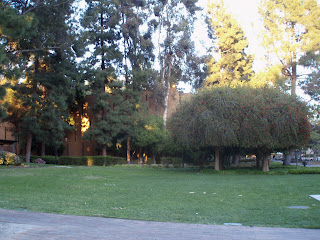
This weekend I was lucky enough to make a trip down to the Sierra Nevada mountains, to collect some data for Glen. Three of his other grad students (Abbie, Christine, and Steph aka Dr. Pau) took me (The newbie aka Hollywog) up to experience field work at 10,000ft elevation! After stocking up on trail mix, chlorophyll supplements (they help oxygenate the blood), and warm clothing we all drove up together. We collected data loggers (looking at temperature variance in the air, at lake bottom, and lake surface) that had been planted there in the spring at 3 different lakes, and took lake sediment samples of each lake with a
Mini-Glew. Glen has been collecting this data for about 20 years in order to obtain information on the short term effects of climate change in lakes at high altitudes.

Holding part of the Mini Glew! This is what we used out on the lakes to sample lake sediment. Notice lake sediment aka brown sludge on hands.

Parker Lake...my favorite. So beautiful.
 Hike to Parker Lake
Hike to Parker Lake. We were at the Ansel Adams National Forest...named after the artist of course.

Barrett Lake.

Heart Lake and Abbie pumping up the boat (aka MJ Thriller named in previous years)

the hike back from Parker Lake... beautiful.
Quaking Aspens, or
Populus tremuloides. These were everywhere on this hike through Ansel Adams National Forest. They are called 'quaking aspens' because when the wind blows through them they seem to quake in the way the leaves move. Hopefully you can see that here. They also make a very unique/beautiful rustling noise. Aspens are also interesting because one individual aspen organism is actually an entire stand of trees. They reproduce by root sprouts, so that each tree in one stand is a clone of one another. Their unique root system is completely interconnected. Because of this, it is difficult or impossible to tell how old an aspen is; since the original tree that began the stand may have died off long ago. Maybe these are some of the oldest trees on earth??? <
Here is an aspen stand that may actually be the oldest (and heaviest) organism on earth.>
Anyway, the hiking was amazing, the air was clear (also maybe a bit thin), and hopefully the data will be useful! This trip has certainly reinforced my love for field work, and for science and nature in general. I would highly recommend visiting the Mammoth lakes region in the Sierras if you ever have the chance. Did I mention that we also drove by the San Andreas fault, waterfalls formed by volcanic and glacial activity, an airplane graveyard (creepy), and the remains of a Japanese concentration camp (disturbing and creepy)? Who says that California doesn't have history!?
 (picture from Danish Center for Ice and Climate)
(picture from Danish Center for Ice and Climate)




















